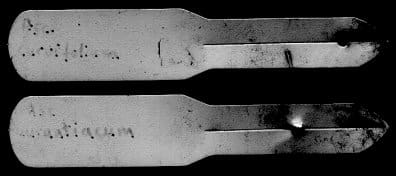Keeping your orchids properly and legibly labeled is an important part of orchid growing. Selecting the proper label stock and writing instrument are key.
One of the most durable labels available is thin piece of aluminum metal into which the plant name has been embossed. Such labels are commercially available, and can be written on with an ordinary pencil or ball-point pen. Some have recommended cutting soda- or beer cans into strips for that purpose, but the edges are very sharp, and the aesthetics are not the best.
Wooden labels are also available, and they hold pencil or permanent marker ink quite well, but your plants’ roots will grip them quite nicely, they are a good substrate for growing algae, and they will rot, especially the end submerged in the medium.
Most of us rely on plastic label stock. The preferred materials are polystyrene and vinyl (polyvinyl chloride, or PVC), as they are waterproof, long-lasting, and can be easily separated from roots. Most labels come with a shiny side and a somewhat rougher side. Use the rougher side to make your writing more durable.
Your choice of writing instrument is also very important. An ordinary permanent marker just doesn’t cut it, as the ink will fade with exposure to sunlight.
Graphite pencils are a good choice, as they are cheap and easy to get, the writing is waterproof and fade-proof, but may be smeared relatively easily.
Pilot used to make a “photographic marker” that could be found at good photo supply stores and probably special-ordered from your local office supply store. They had a fine point, and the black ink is very stable and fade-proof. Unfortunately, they were on the expensive side, near a couple bucks each. I recently (June 2012) contacted Pilot to see if they could supply them, and they pointed me to a new “art pen”, the “Pilot ultra fine point permanent type NO XYLENE SCA-UF”, and they seem to be a reasonable replacement, lasting about two years in direct sun outdoors.

Sanford’s Sharpie Markers are an old standard, but are prone to fading. They recently came out with an “industrial” version, and the Extra Fine Point pens are a pretty good alternative. An “Ultra Fine” version would be better, but the ink does appear to be extremely stable.
The photo below is a label that was been sitting on one of my greenhouse benches for approximately 20 months, where it was exposed to water, fertilizer, insecticides, hydrogen peroxide and chlorine bleach disinfectants, and of course, the sun. The date was written in pencil, the others are self explanatory.

Other alternatives appear to work quite well, too: if you have a lot of labels to make up, and can get your label stock in sheets or rolls, both laser printers and ink jet printers can be used. The laser-printed labels appear to be pretty durable as-is, but the ink jet labels will have to be coated with an acrylic spray after they dry, to protect them from water.
Label printers such as the Brother P-touch are another excellent choice, with the black-on-white and black-on-clear laminated tapes being the best in terms of stability.
Recovery of Faded Labels
Now then, what do you do if your label has faded to the point of being unreadable? Don’t despair, as – unless it’s totally blank – you can use your computer hardware and software to help recover the “lost image.” The example below utilized an HP scanner and Paint Shop Pro software.
The image below is a couple of labels from plants I recently acquired. I know they were both ascocentrums, but what species?

The HP scanning software allows some manipulation of the output type, so I changed it from true color to grayscale, and adjusted the highlight/midtone/shadow settings to give the following image, which allowed me to identify my plants as Ascocentrum curvifolium and Ascocentrum aurantiacum!

If your scanner does not offer such controls, or if you’re working with a shot from a digital camera, similar image manipulation can be done with image editing software. In this image, I used Paint Shop Pro to increase the “shadow” value from zero to 80%:

A photo taken with a digital camera can often be manipulated similarly.
I have also gotten a suggestion that an ordinary blacklight can work on some plastic labels. If the plastic formulator added “brighteners” to the plastic, they will fluoresce, but will be masked by the ink residue, darkening the writing.
If you have questions, comments, or need assistance recovering a faded label, please feel free to drop me a line .